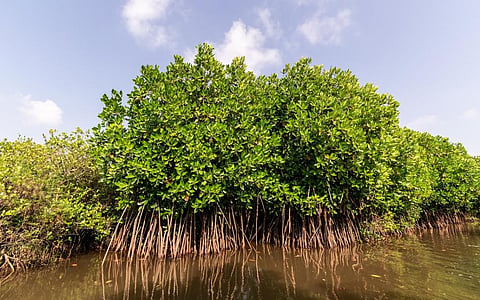

Finance Minister Nirmala Sitharaman announced a new initiative for mangrove plantations along the coastline and on saltpan lands in her budget speech on February 1, 2023.
Experts hailed the move, calling it an essential step in the fight against the climate crisis. But they stressed that the initiative should be carried out scientifically.
The MISHTI, ‘Mangrove Initiative for Shoreline Habitats & Tangible Incomes,’ comes after India joined the Mangrove Alliance for Climate launched during the 27th Conference of Parties (COP27) to the United Nations Framework Convention on Climate Change held in Egypt in November 2022.
“It is a significant announcement. World leaders have been discussing using mangroves as a tool for climate action at the global level, Nehru Prabakaran, a scientist at the Wildlife Institute of India, told Down To Earth.
Mangroves cover only about 0.1 per cent of the planet’s surface. Yet, they can potentially store up to 10 times more carbon per hectare (ha) than terrestrial forests.
Further, these plantations can protect coastal communities by acting as a natural barrier against storm surges. Mangrove ecosystems prevent more than $65 billion in property damage and reduce flood risks for around 15 million people yearly, according to scientists.
“Coastal forests like Mangroves are emerging as a key solution to address global warming and other adverse climate events like increased storm and cyclonic activity across the globe, impacting lives and livelihood,” WWF-India told DTE.
In India, the total mangrove cover is 4,992 square kilometres, according to the 2021 Forest Survey Report (FSR).
The country lost 40 per cent of its mangrove cover during the last century. Kerala, for instance, lost 95 per cent of its mangroves in the last three decades, according to a study. This decline has been attributed to the conversion of the habitat to agriculture, aquaculture, tourism and urban development.
But efforts are being made to restore them. The 2021 FSR recorded an increase of 17 square km in mangrove cover relative to the previous assessment of 2019. Odisha, Maharashtra and Karnataka are ranked top in terms of mangrove cover.
Several states have taken up restoration projects. For example, a study found that two districts in Gujarat used community-based efforts to achieve the plantation and preservation of mangroves over an estimated 5,000 ha of mangrove land, according to Mongabay.
“State-level actions can only contribute to a certain extent. But the announcement from the Union government can provide the necessary boost for large-scale plantation,” Prabakaran said.
MISHTI could potentially attract private resources and carbon and biodiversity offsets, WWF-India pointed out.
As these salt-tolerant trees store most of the carbon in their soil and sediments, they can stay locked for a millennium if left undisturbed.
Mangroves are important nursery and breeding grounds for fish. Restoration projects worldwide can potentially lure the carbon offset market, which facilitates increased carbon credits trading.
However, mangrove restoration projects have tasted limited success. For instance, Sri Lanka brought 1,000-1,200 ha of mangroves under restoration. But they achieved success only in about 200-220 ha.
The survival level of the restoration project sites ranged from 0-78 per cent, according to a 2017 study.
Choosing the wrong species in the wrong location or site may not be suitable for mangrove plantations, Prabakaran warned
The failure was due to unscientific methods of cultivation. Planting mangrove seedlings at the incorrect topography provides unconducive soil conditions for these salt-tolerant trees, according to a study on the Sri Lankan restoration project.
“We must take advantage of the available scientific information and use it in our plantation efforts,” Prabakaran stressed.
Further, climate change poses a threat to mangroves. It has been reported that these trees are migrating upstream in the river Hooghly.
This could be driven by changes in pollution load, mean sea-level rise, and anthropogenic activity, according to a 2020 study.
“Sea-level rise is happening on the Indian coast. We do not know how vulnerable Indian mangroves are to this change,” Prabakaran highlighted, adding that his team is initiating studies to address this knowledge gap.
Having this information could help researchers devise a site-specific strategy. For instance, mangroves in the Sundarbans may cope differently than those in Kerala, he noted.
Further, MISHTI has the potential to improve livelihood. “The initiative could potentially generate and contribute to livelihood through initial engagement for plantation, tourism initiatives in regenerated areas and increased catch of commercial marine resources,” WWF-India said.
But, the non-governmental organisation added that it was too early to comment on how the initiative could improve livelihoods. “Unless we thoroughly discuss the budgetary allocation, it is too early to comment on this,” they said.
Sitharaman made no mention of budgetary allocation for the scheme during her speech. The Ministry of Environment, Forest and Climate Change has been allocated Rs 3,079.40 crore in the 2023-2024 Union Budget.